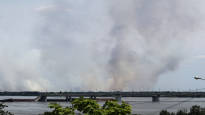Ukrainian forces appear to have broken through Russian defense lines on the banks of the Dnieper River in southern Ukraine near Kherson this week.
An American think tank reports on the attack ISWwhich bases its information on the publications of Russian war bloggers.
The Ukrainian landing site is located about 40 kilometers from Kherson near the village of Kozachi Laheri.
According to Russian war bloggers, on Tuesday, seven Ukrainian boats arrived on the Russian-occupied eastern bank of the Dnieper. There were 6–7 people in each boat.
Ukrainian forces are said to have advanced as far as 800 meters from the river bank before Russian forces halted the advance.
If Ukraine has really managed to break through the Russian defense lines, it would be the first significant advance in months on the southern Ukrainian front line.
An expert following the war in Ukraine John Helin says that for now it is difficult to assess the significance of the landing in Kozachi Laher for the Ukrainian counterattack.
– It is difficult to see that Ukraine would build the conditions for a breakthrough that would liberate large areas around Kozachi Laher.
According to Helin, crossing the river to liberate the areas is difficult as a combat strategy. For example, moving heavy equipment across a river is laborious.
Did Ukraine attack in a surprising direction?
Russian war bloggers wrote on Wednesday, according to ISW, that the Ukrainian forces managed to make a tactical surprise.
However, according to Helin, it is not at all surprising that Ukraine chose Kozachi Laher as its landing place.
– The Ukrainians landed on the east bank of the Dnieper at the same time when Russia carried out the transfer of a unit of the air transport regiment from Kozachi Laher to the Zaporizhia region.
During the invasion of Ukraine, Kozachi Laher was mostly Russian reservists.
According to Helin, Ukraine is clearly taking advantage of the inexperience of the Russian reservists and is now attacking places where there are few Russian troops or where the defense is weak
Helin estimates that Ukraine is aiming for a kind of panic among Russians. Panic would force Russia to withdraw its large forces to smaller front blocks from tactically important areas.
Many things still unclear on the Dnieper
Satellite images confirm that there has been fighting on the banks of the Dnieper River, but many things about the Kozachi Laher strike are still unclear.
The Ukrainian Armed Forces have not confirmed the information that Ukraine has established a new bridgehead station on the east bank of the Dnieper River.
Also, ISW has so far seen no evidence of a significant number of Ukrainian soldiers east of the Dnieper near the village of Kozachi Laher.
– It is still uncertain whether the Ukrainian forces have achieved a permanent presence on the east bank, says Helin.
Member of the Russian Kherson occupation regime Vladimir Saldo claimed in his Telegramthat Russia repelled the Ukrainian landing attempt with artillery fire in the Kherson region.
The front line runs through the Dnieper
Ukrainian troops have tried to cross the Dnieper many times. After the counter-offensive started at the beginning of the summer, the Ukrainian troops were expected to finally cross the river.
The failure of the Kahovka dam in June made the situation more difficult. The dam failure caused the Dnieper to widen in central areas and made crossing the river slow and dangerous.
Downstream of the Kahovka dam, no significant changes have been seen in the fighting since the dam broke.
On the islands of the Dnieper estuary, there have been small battles over island villages and forest strips during the summer, but Ukraine has not made a major breakthrough on the Dnieper.
According to Helin, the explanation can be found by looking at the map.
– In a river war, there are usually limited places to disembark, and it is difficult to move through the water without being noticed. In addition, the map does not show where the high embankments are located, which prevent heavy equipment from crossing the river.
River warfare also involves many logistical challenges.
– Modern warfare needs constant maintenance. Organizing the maintenance of ammunition, fuel and other equipment across a wide river is really challenging. Especially if there are no bridges in use, says Helin,
Ukraine still maintains a bridgehead at the southern end of the Antonivskyi bridge. Russia, on the other hand, has lost access to many bridges and has tried to build light pontoon bridges to replace the destroyed waterways.
However, such bridges are not sufficient for transporting heavy equipment and material.
Helin believes that the purpose of the bridge strikes was to cut off the access of Russian maintenance forces to the Kherson bases.
